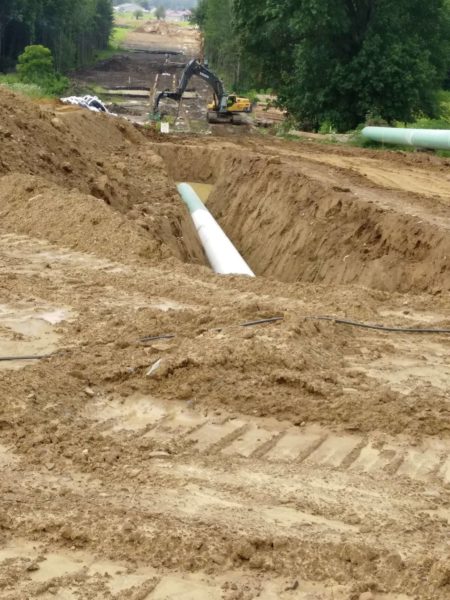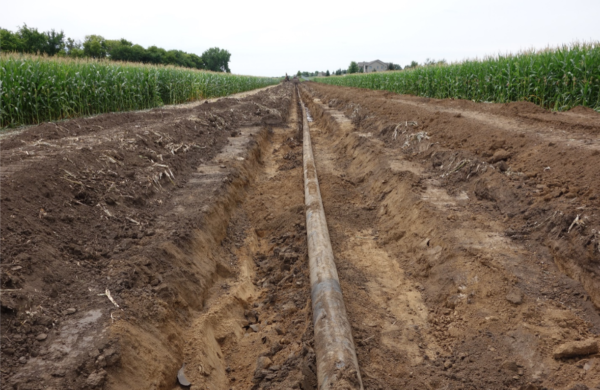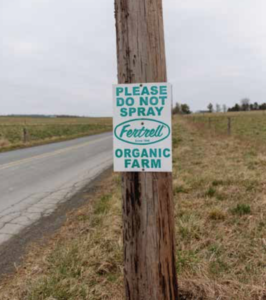On a crisp fall day, you could be thinking about your next farm chore while having your noon meal, and hear a knock at the door. A nice person informs you that your land will be needed for a natural gas pipeline, and they are here to survey the property and have you sign an agreement. They might have an aerial map and show you where the pipeline will be placed, and perhaps offer you some monetary compensation. They could make it seem that you do not have any choice, and that you might as well sign an agreement now so you can get on with your day. In this scenario, you can replace “natural gas pipeline” with “electric transmission line” or with other types of energy infrastructure. These conversations are becoming increasingly common in many areas of the country and many organic growers have had to fiercely advocate to protect their organic land.
Here’s what to know:
- You have options. You could fight the proposed route, or offer a different route (use a field edge rather than through the middle). Some, but not all, states allow companies “eminent domain” which could restrict your ability to deny land access to the company. However, eminent domain still provides “fair treatment and just compensation,” which will be negotiated between you and the company.
- Don’t be intimidated to decide quickly. You have time to do the research needed, and to determine what placement and compensation you are willing to accept for both the short and long term. There is no need to panic, even if the company tells you this is urgent (it is not). Don’t sign anything until you have done the research or hired an attorney to help you modify the company’s agreement so your interests are included.
- Finding the information will take some time. You may need to hire a lawyer familiar with your state’s rules and precedents. Your neighbors may wish to contest or modify the route and/or compensation proposed. If there are numerous landowners working together, this strengthens your case and shares the cost of legal advice.

dairy operation owned by third-generation farmer James Yoder in Northeast Ohio. The pipeline transports natural gas from fracking from Ohio to Canada, and crosses through 11 acres of Yoder’s farm.
Most of the new energy infrastructure being proposed is overseen by your state, not by the federal government. The state provides public information on these projects. This public information includes the specifications of the infrastructure, the timeframe, and any proposed plans to mitigate the damage caused by construction. Agricultural lands are significantly impacted by energy infrastructure activities, with biological and organic farmers affected more deeply and long-term than farmers who rely on chemicals for fertility, weed and pest management. Most companies have more than one proposed route, and knowledge of other route options can help make a case that your certified organic land is special and should be avoided altogether.
Prevention of damage is better than dealing with the problems after they happen. For biological and organic farmers, the long-term investments in building ecological balance on your land, as a basis for your farm’s productivity, cannot be easily rebuilt in a short amount of time. This should be communicated to the company. Protection of your market premiums and your ecosystem (both above and below the soil line) through proactive agreements are essential when dealing with energy companies. Do not underestimate the cost and time of rebuilding of your land after construction. Make sure your compensation agreement includes one to five years of mitigation costs, as well as losses due to lowered productivity.
Considering Compensation
 For digging or drilling where soil is to be disturbed, keep in mind there will be significant settling, possible erosion, and compaction from heavy equipment. There will also be an impact to water infiltration and capillary action. The weather, slope of the land, soil type(s) and other factors will influence the amounts of compaction or erosion. New and more numerous weed seeds will germinate, perhaps weeds you haven’t seen for decades! Healthy, diverse and well managed pastures will take numerous years to regain the biomass and palatability compared to before the construction. When topsoil is put back on top after digging is completed, these areas do not have the same soil horizons, drainage and nutrient movement as before the disturbance. Use of herbicides and chemical fertilizers can lessen the loss of crop yields, but those who rely on healthy soil biology and tilth for productivity, will suffer for numerous years until the land heals. Compensation which pays for the intensive use of diverse cover crops to improve the soil can be included in your agreement, as well as other soil-building techniques you identify.
For digging or drilling where soil is to be disturbed, keep in mind there will be significant settling, possible erosion, and compaction from heavy equipment. There will also be an impact to water infiltration and capillary action. The weather, slope of the land, soil type(s) and other factors will influence the amounts of compaction or erosion. New and more numerous weed seeds will germinate, perhaps weeds you haven’t seen for decades! Healthy, diverse and well managed pastures will take numerous years to regain the biomass and palatability compared to before the construction. When topsoil is put back on top after digging is completed, these areas do not have the same soil horizons, drainage and nutrient movement as before the disturbance. Use of herbicides and chemical fertilizers can lessen the loss of crop yields, but those who rely on healthy soil biology and tilth for productivity, will suffer for numerous years until the land heals. Compensation which pays for the intensive use of diverse cover crops to improve the soil can be included in your agreement, as well as other soil-building techniques you identify.
Wetlands, meadows and other lands not specifically growing crops or pasture can provide pollinator and beneficial insect habitat, biodiversity, and protect water quality. If the infrastructure is proposed to go through these lands, make sure your agreement includes compensation for the value lost and time and mechanism to repair.
Getting It On Paper
Organic farmers should develop a Mitigation Plan Agreement with the energy company that covers all aspects of organic integrity. This should also be shared with your organic certifier. Some negotiations included in the agreement could include: Equipment cannot have residues of nonorganic soil and should be removed from the organic land for refueling and storage every evening and on weekends to avoid accidental leakage of oils and fuel. Tarps should be used during construction to prevent foams, welding flux and other materials from falling on and contaminating the land. When reseeding, no prohibited seed treatments, fertilizers or other materials are allowed, including bringing in nonorganic soil to deal with settling. A trained organic inspector should be hired at company cost, to oversee construction and to have the power to stop activities if there are issues. There is zero tolerance in the organic regulations for the application of prohibited materials on organic land, and if the company applies a “historically persistent” material (i.e., hydraulic fluid, diesel, persistent pesticides, etc.), the land could be decertified for more than 3 years.
These type of energy infrastructure agreements include electric powerlines that have been around for almost a century and newer types of energy infrastructure such as wind turbines, solar farms and cell towers that are more recent additions to the landscape. On-going management of these energy infrastructures typically present a problem with restricting the use of herbicide, since these utilities do not want brush or trees interfering with the infrastructure or access to it. Landowners can work with utilities by having a No Spray Agreement spelling out whose responsibility it is to maintain the area under and around power lines and other infrastructure to prevent the risk of service loss. Many electric companies have no spray agreements which mandate landowner maintenance under powerlines to the utility’s satisfaction, and if not done, then the utility will spray.
 Landowners can provide an Addendum to the No Spray Agreement that requires the utility to provide notification and give the landowner at least 30 days to cut the offending brush before a spray is used. For organic fields or pastures that have utility lines, spray prevention is essential. Signage on all field entrances and/or along roadsides, stating no sprays are allowed, can notify contracted applicators to avoid this area. When there is an agreement and signage, but the land is sprayed by the utility, you are more likely to receive compensation for lost productivity and crop/livestock market premiums.
Landowners can provide an Addendum to the No Spray Agreement that requires the utility to provide notification and give the landowner at least 30 days to cut the offending brush before a spray is used. For organic fields or pastures that have utility lines, spray prevention is essential. Signage on all field entrances and/or along roadsides, stating no sprays are allowed, can notify contracted applicators to avoid this area. When there is an agreement and signage, but the land is sprayed by the utility, you are more likely to receive compensation for lost productivity and crop/livestock market premiums.
Many states work with Field Watch which provides a free registry for beekeepers, specialty crop producers (including hemp) and row crop growers to register their fields for free. Applicators can then review these locations and are aware to avoid spraying that land.
Takeaway: Even though the energy companies are large and powerful, landowners have many options to protect their land. Be proactive, organic farmers have been successful in getting energy routes changed after strongly advocating for protection of their organic status.
Harriet Behar owns Sweet Springs Farm in Gays Mills, Wisconsin. She is an Organic Farmers Association Governing Council member.
This article originally ran in the 2020 issue of New Farm Magazine, the magazine of the Organic Farmers Association. All OFA members receive a complimentary issue of New Farm annually. Join today.
